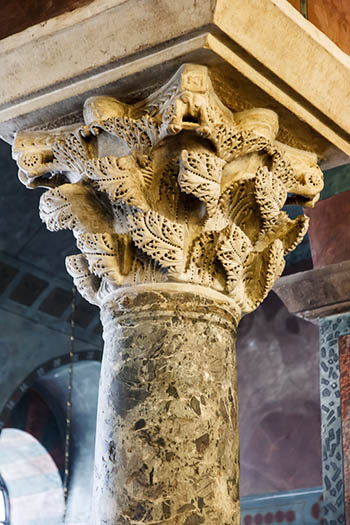 An example of a "wind-blown" acanthus capital on a column of verde antico.
An example of a "wind-blown" acanthus capital on a column of verde antico.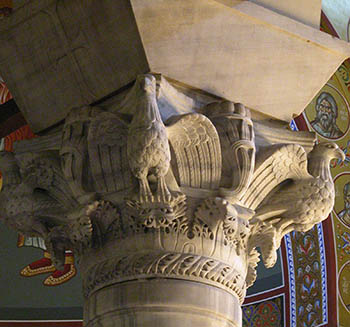 Here is capital carved in proconnessian white marble with eagles.
Here is capital carved in proconnessian white marble with eagles.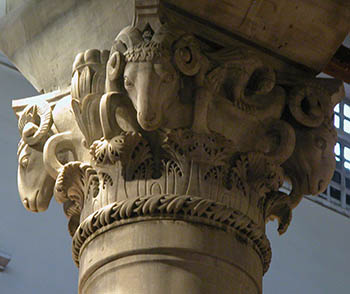 Here in place of eagles we see ram's heads.
Here in place of eagles we see ram's heads.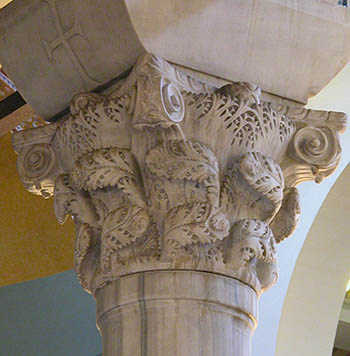 Another example of "wind-blown" acanthus on a column of white proconnesian marble.
Another example of "wind-blown" acanthus on a column of white proconnesian marble.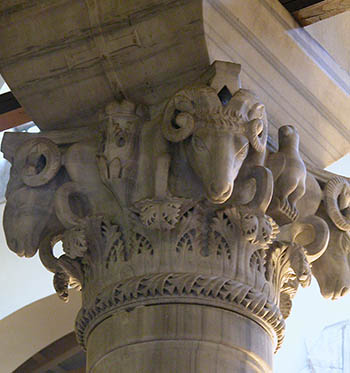 All of these capitals are carved in white proconnessian marble.
All of these capitals are carved in white proconnessian marble.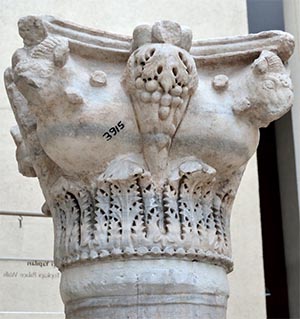 This battered capital was found on the grounds of the Mangana Palace and Church of Saint George of the Mangana. It's now in the Istanbul Museum.
This battered capital was found on the grounds of the Mangana Palace and Church of Saint George of the Mangana. It's now in the Istanbul Museum.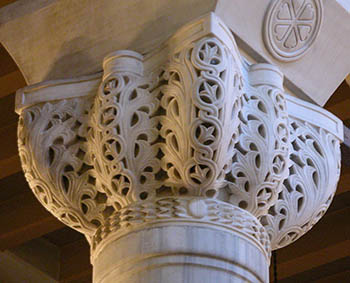 A basket capital.
A basket capital.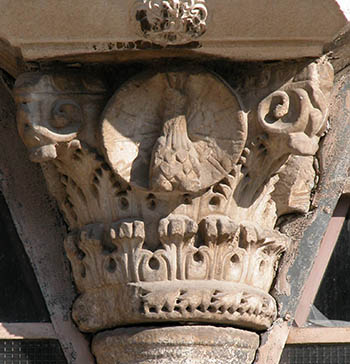 This capital originally had a peacock in the center which has broken off. It is on the exterior of a Byzantine building in Thessaloniki.
This capital originally had a peacock in the center which has broken off. It is on the exterior of a Byzantine building in Thessaloniki.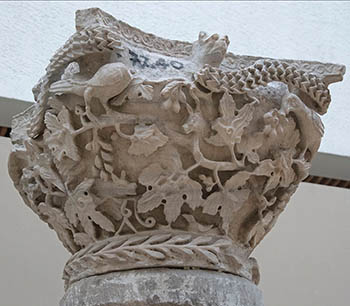 This is a beautiful lace capital with grape vines, grapes and birds eating them. The top of the capital is wrapped with the body of a snake. It is now in the Istanbul Museum. Perhaps this is the most beautiful capital that has survived from Constantinople.
This is a beautiful lace capital with grape vines, grapes and birds eating them. The top of the capital is wrapped with the body of a snake. It is now in the Istanbul Museum. Perhaps this is the most beautiful capital that has survived from Constantinople.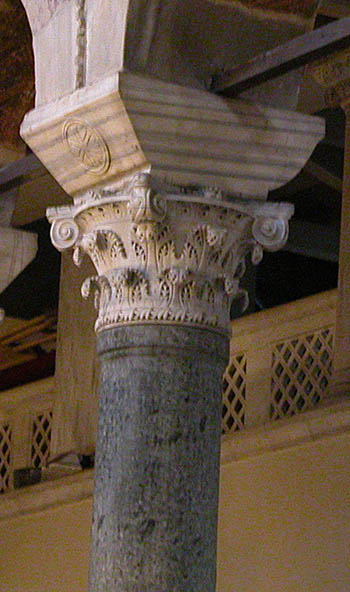 A beautiful Theodosian capital from Thessaloniki.
A beautiful Theodosian capital from Thessaloniki.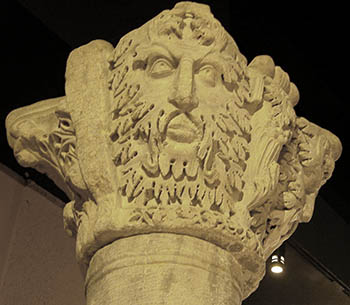 A wonderful "Green Man" capital in the Istanbul Museum. Green Men can be seen in the floor mosaics of the Great Palace.
A wonderful "Green Man" capital in the Istanbul Museum. Green Men can be seen in the floor mosaics of the Great Palace.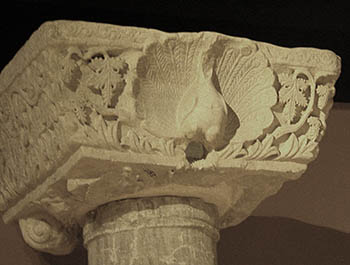 An ionic impost capital with a peacock.
An ionic impost capital with a peacock.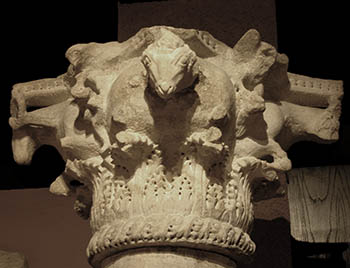 A capital with bull heads from the Istanbul Museum
A capital with bull heads from the Istanbul Museum

Mosaics of Hagia Sophia in Thessalonki
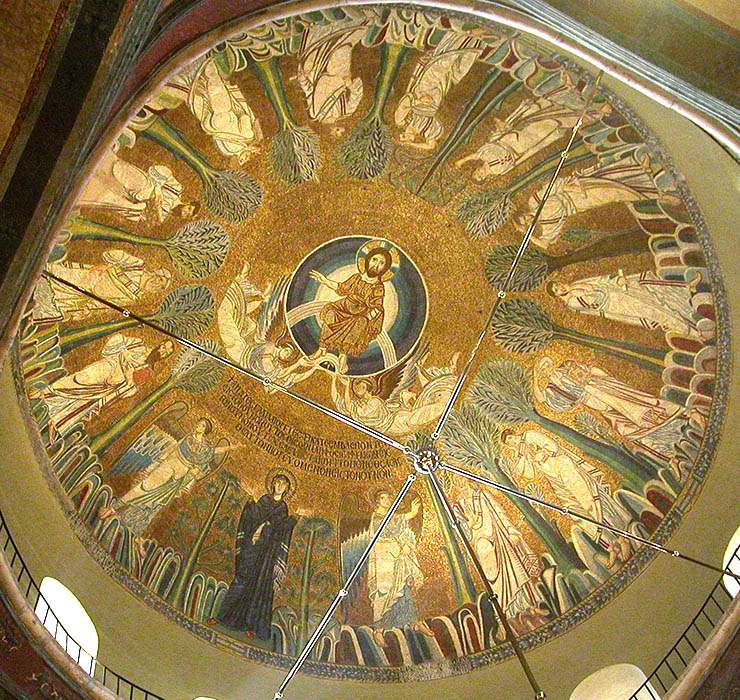 The church was founded around 783. The first decoration in the apse was of a large cross that was later replaced with one of the Theotokos and Christ.
The church was founded around 783. The first decoration in the apse was of a large cross that was later replaced with one of the Theotokos and Christ.
In 1430 the city of Thessaloniki had been conquered by the Ottoman Turks and all of the churches in the city were converted into mosques. The conversion of Hagia Sophia into a mosque was ordered by the Grand Vizier of Sultan Suleiman I, Ibrahim Pasha, who was strangled on 15 March 1536. At the time of the conversion between - 1520 - 36 - he built a minaret and a fountain in the garden at the same time. Saint Demetrios had already been converted into a mosque in 1492 by Sultan Bayezid II called Kasimiye Camii.
It was only in late Turkish times, around 1890, that the figures in this dome were covered over with trees painted in oil paints. Until then the mosaics in the dome were exposed and not covered over. The faces had been disfigured by deliberate hacking by Muslims. There was a great fire in the city in 1890 that covered the mosaics of Hagia Sophia with a thick layer of soot and left a mess in the apse of old plaster, Turkish inscriptions and traces of ancient mosaic. The capitals of the south aisle were damaged in the fire and were replaced with plaster copies of the the capitals of the north aisle.
Between 1907 and the reconquest of the city by the Greeks in 1912 the Ottoman authorities began an effort to conserve and restore the mosaics. The roof was redone and the surface of the mosaic was cleaned. At the time the city was multi-national composed of Muslim Turk, Jewish and Christian Greek communities. Charles Diehl, the French Byzantinist, worked on the mosaics, especially the Theotokos in the apse. Damage had been done to the faces and the gold stars on the shoulders of the Virgin's maphorion had been hacked out. It is not clear how much of Christ's face had been over-painted in the restoration.
In 1941 the mosaics of the apse were restored and the gold background was reset. Missing tesserae in the two figures was replaced. The suture lines showing the area of replacement of a vast iconoclastic era gold cross with the figure of the Virgin and Child were destroyed. Now it can only be studied in old photographs.
The dome mosaics were fully restored in 1980. The figure of Christ in Glory was in excellent shape.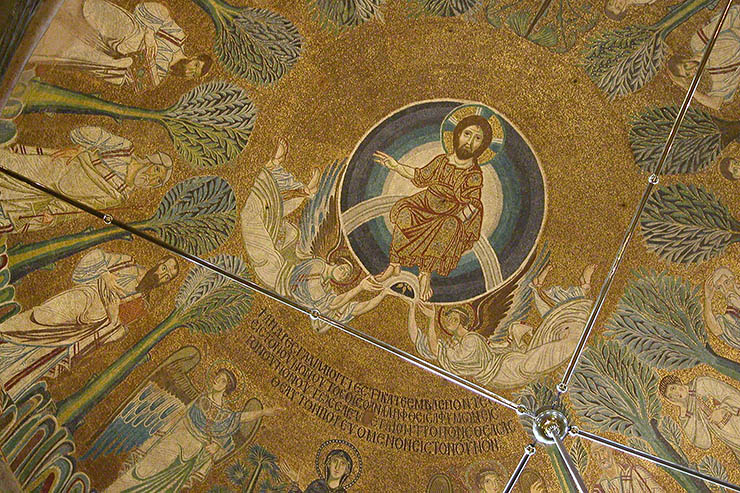 Christ was seen by an Italian traveler, the Venetian Ambassador, who could in 1591 still see the Pantokrator in the dome of Hagia Sophia.
Christ was seen by an Italian traveler, the Venetian Ambassador, who could in 1591 still see the Pantokrator in the dome of Hagia Sophia.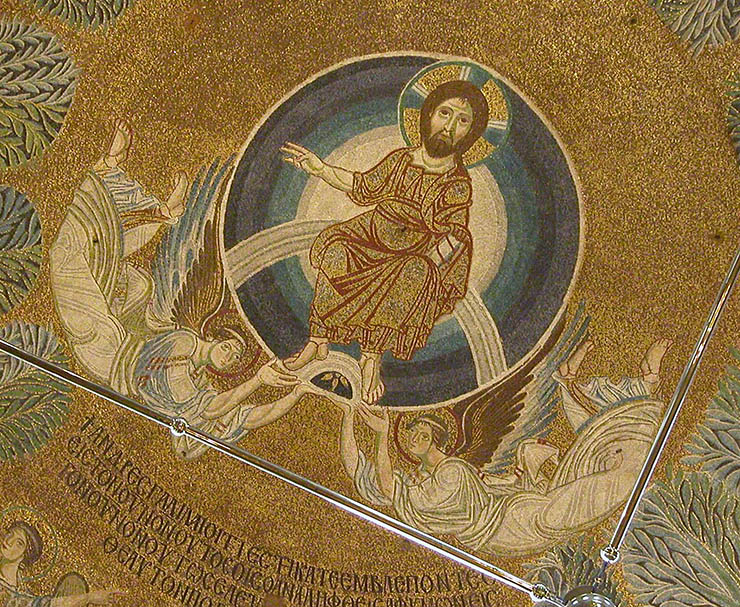 The mosaic in the dome represents the Ascension with the inscription from Acts 1:11 "Ye men of Galilee, why stand ye gazing up into heaven?". The dome is ringed by the figures of all Twelve Apostles, Mary and two angels.
The mosaic in the dome represents the Ascension with the inscription from Acts 1:11 "Ye men of Galilee, why stand ye gazing up into heaven?". The dome is ringed by the figures of all Twelve Apostles, Mary and two angels. 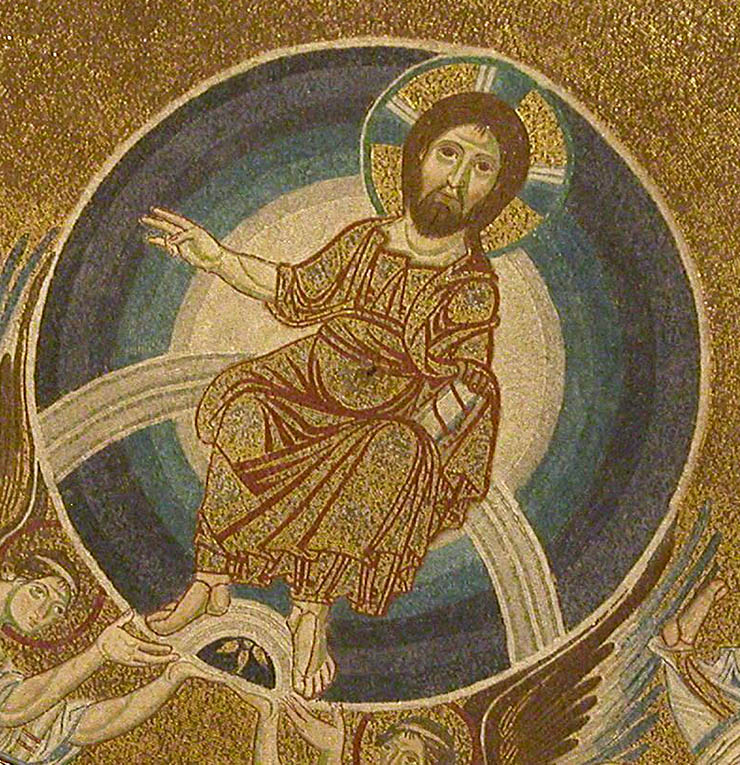
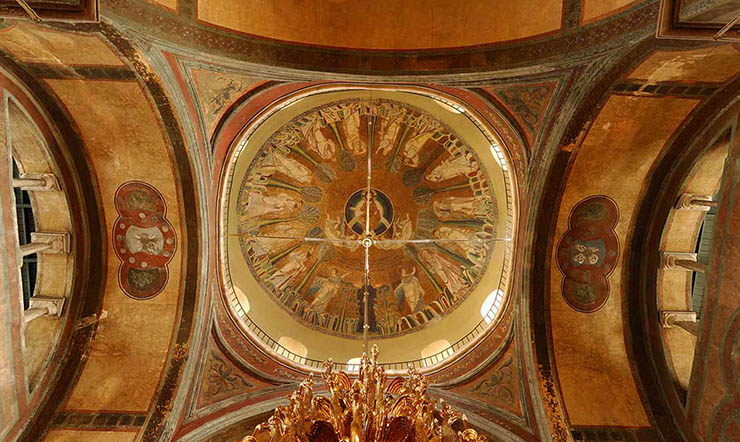
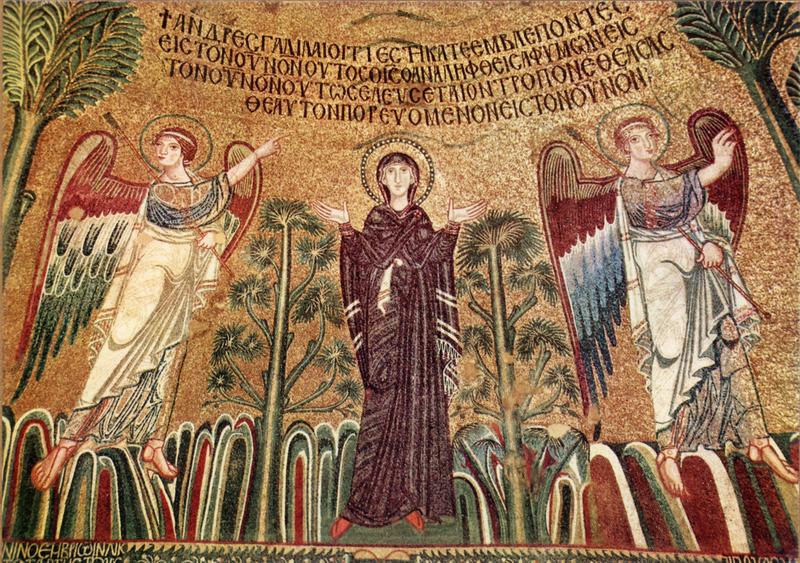 The two angels above are very different and must have been done by different artists. This can be seen in the wings, the size of the faces and hands. Look at the 'earth' below and see how big the lumps are beneath the angel on the right compared to the one on the left.
The two angels above are very different and must have been done by different artists. This can be seen in the wings, the size of the faces and hands. Look at the 'earth' below and see how big the lumps are beneath the angel on the right compared to the one on the left.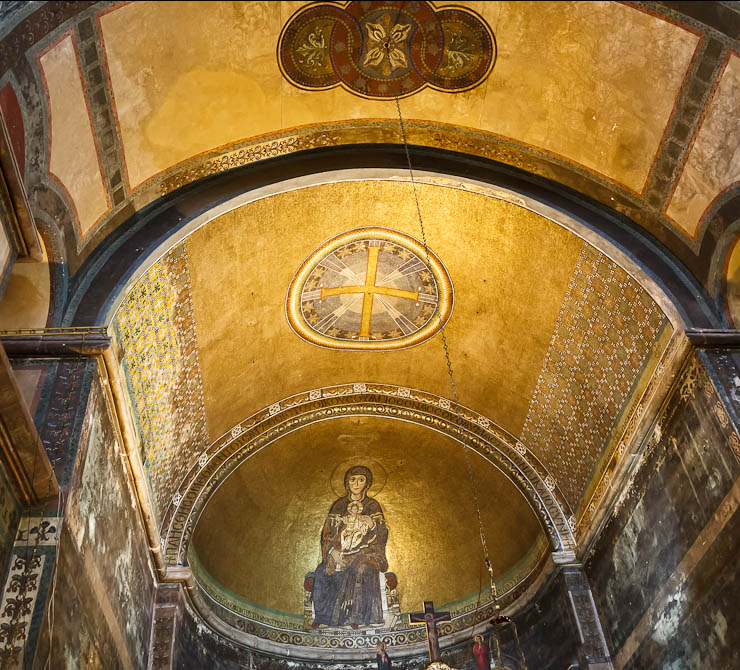 The original Theotokos has been dated, along with the mosaics in the dome, to around 1038 after a series of major earthquakes required restoration of the church. The Theotokos was made by a local artist while the mosaics in the done were probably completed by a workshop sent from Constantinople.
The original Theotokos has been dated, along with the mosaics in the dome, to around 1038 after a series of major earthquakes required restoration of the church. The Theotokos was made by a local artist while the mosaics in the done were probably completed by a workshop sent from Constantinople.
In later Turkish times the figures of the Theotokos and Christ were obscured by Islamic inscriptions and overpaint. Visitors to the mosque in the 19th century tell us the figure was badly damaged. Rain penetration in 1907 caused more damage. In the restoration of 1907, the roof was overhauled, the surface of the mosaic cleaned, and the areas of loss filled in with plaster. In 1941 further restoration replaced gold cubes that had fallen away around the figure of the Virgin.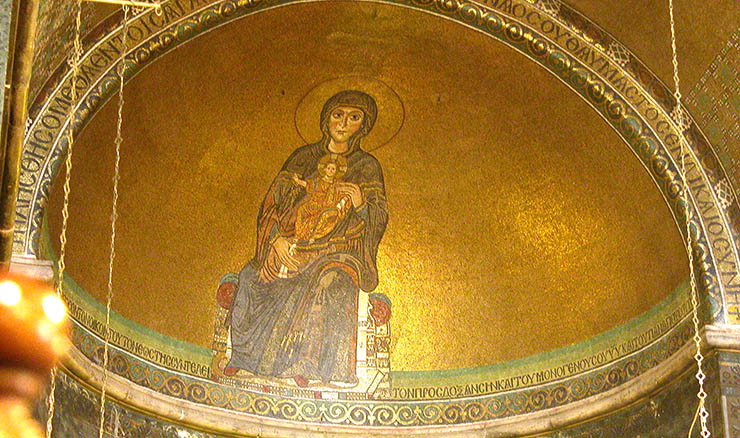
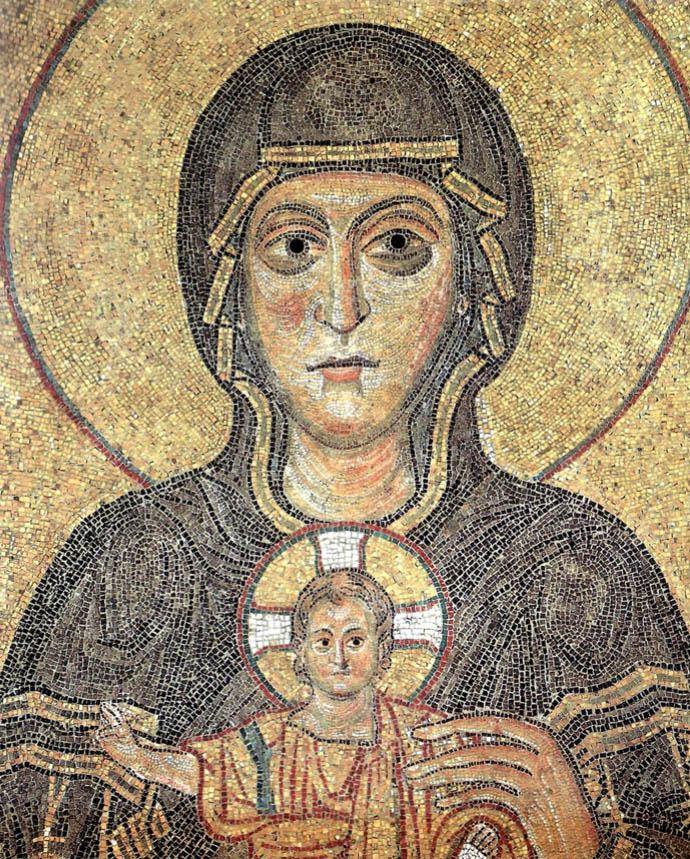 Above you can see on the head and both shoulders were gold mosaic stars were hacked out of the mosaic. Purple or painted artificial cubes were added to fill in the spaces.It's a mystery why this was done when it would have been easy to restore them in real gold tesserae.
Above you can see on the head and both shoulders were gold mosaic stars were hacked out of the mosaic. Purple or painted artificial cubes were added to fill in the spaces.It's a mystery why this was done when it would have been easy to restore them in real gold tesserae.
The robes of the Virgin are made up of multi-colors, which is unusual. Here we can see that the figure of the Theotokos has penetrated into the inscription below. The inscription was associated with the earlier mosaic of a cross which this image replaced. Experts believe that the figure was executed in two parts - half way down the scaffolding was moved and the figure was then readjusted to its space. It is thought the artist was originally a painter of frescoes and icons, who had little experience in mosaic work. The modeling of the face in streaks is not the technique an experienced mosaic artist would have used.

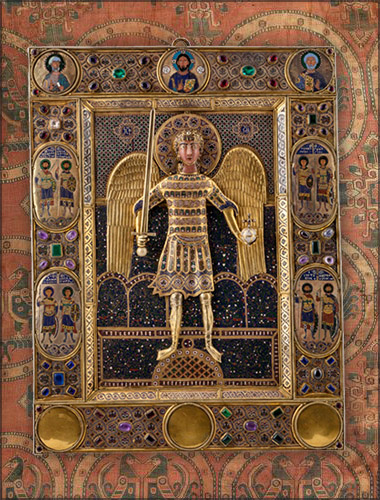


 click here for icons of christ
click here for icons of christ click here for icons of the theotokos
click here for icons of the theotokos click here for icons of angels
click here for icons of angels click here for icons of saints
click here for icons of saints








